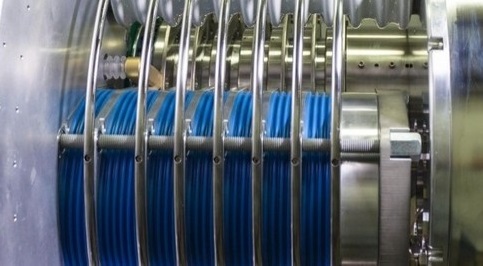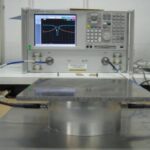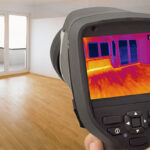Also known as: Neutron Imaging, N-Ray Radiography, Neutron Tomography
| Similar to x-ray radiography, neutron radiography is a very efficient tool to enhance investigations in the field of non-destructive testing (NDT) as well as in many fundamental research applications. Neutron radiography is, however, suitable for a number of tasks impossible for conventional x-ray radiography. The advantage of neutrons compared to x-rays is the ability to image light elements (i.e. with low atomic numbers) such as hydrogen, water, carbon etc. In addition, neutrons penetrate heavy elements (i.e. with high atomic numbers) such as lead, titanium etc. allowing the study of materials in complex sample environments, for example water accumulation in hydrogen fuel cells: see Fig. 1. Because neutrons interact with the nucleus rather than with the electron shell, they can also distinguish between different isotopes of the same element. This makes neutron radiography an important tool in various research applications and in the field of NDT. The MNRC high neutron intensity beams permit short exposure times, high spatial resolution and high sample throughput. |  Fig. 1. Left: Photograph of a hydrogen fuel cell. Right: False colored neutron radiograph of a fuel cell showing the water content of the cell during operation. Fig. 1. Left: Photograph of a hydrogen fuel cell. Right: False colored neutron radiograph of a fuel cell showing the water content of the cell during operation. |
Methods of neutron radiographyThe detection of neutrons relies on a conversion into visible light; to achieve this, conversion screens containing either Gd or 6Li and a fluorescence material are commonly used. After the conversion the emitted light can be detected by different media such as:● Film, that is then developed in a dark room and results in a permanent image,● Imaging Plates, that can be re-used after being processed by an image reader. (The technology is very similar to x-ray imaging plates used at medical offices),● Digital cameras (CCD, CMOS), allow to capture the image digitally.Differences between neutron and x-ray radiographyNeutron radiography is based on the principal that neutrons interact with the nucleus of the atom, rather than the electrons. Therefore neutrons are absorbed in matter very differently from x-rays and gamma rays. This means that, contrary to x-rays, neutrons are attenuated by some light materials, such as hydrogen, boron and lithium, but penetrate many heavy materials such as titanium and lead. This allows for some unique applications of neutron radiography.The figures below impressively demonstrate how neutron radiography can yield different yet complementary information to x-ray radiography. COMPARATIVE RADIOGRAPHS OF A SLR CAMERA  X-Ray RadiographNeutron Radiograph Fig.2. X-ray and Neutron radiographs of a 35 mm film SLR camera. Dark elements in the x-ray radiographs are caused by metal components; comparison shows that they are almost transparent for neutrons. Dark componets in the neutron radiograph are due to plastic components which in turn are almost transparent to x-rays. ApplicationsNeutron Radiography has a wide range of uses, including:● Imaging casting to ensure that the mold materials don’t carry into the castings as impurities.● Validating the proper fill of pyrotechnical in actuators● Studying the flow of oil in automobile transmissions● Facilitate Fluid flow analysis● Analyze O-ring placements● Image carbon, gun powder grain structure, plastics, lead, and other heavy metals. X-Ray RadiographNeutron Radiograph Fig.2. X-ray and Neutron radiographs of a 35 mm film SLR camera. Dark elements in the x-ray radiographs are caused by metal components; comparison shows that they are almost transparent for neutrons. Dark componets in the neutron radiograph are due to plastic components which in turn are almost transparent to x-rays. ApplicationsNeutron Radiography has a wide range of uses, including:● Imaging casting to ensure that the mold materials don’t carry into the castings as impurities.● Validating the proper fill of pyrotechnical in actuators● Studying the flow of oil in automobile transmissions● Facilitate Fluid flow analysis● Analyze O-ring placements● Image carbon, gun powder grain structure, plastics, lead, and other heavy metals. |
● Testing air-cooled jet engine turbine blades for residual core material and other cooling passage blockages.
● Reliability testing of detonators in explosive devices.
● The inspection of high-reliability explosives for presence of transmitters and receivers and for explosive loading uniformity.
● Inspecting for internal flaws such as cracks, inclusions, voids, bubbles, foreign materials, density variations and misalignments.
● Testing braze quality and the presence of braze materials in manufactured parts.
● Determining capacitor delamination.
● Determining bonding flaws in adhesives.
● Inspecting radioactive objects such as a gamma source in its shielding.
● Determining reliability of air bag or parachute initiators.
● Inspection of artifacts uncovered through archaeological digs.
● Inspecting for aluminum corrosion products.
● Testing for missing or misplaced O-rings.
● Testing for hydrogenous foreign substances in sealed units.
How does Neutron Radiography NDT testing work?
The nondestructive inspection of a material using neutron imaging is very similar to the process used in X-Ray NDT; however, unlike x-rays, n-ray radiography services allow the imaging of organic materials inside a component. Metals in the subject component take on a transparent appearance in neutron radiographic images. In many cases, x-ray and neutron radiography are complementary NDT inspection processes, offering a complete picture not only the integrity of the component, but also of the organics within that component.


